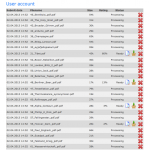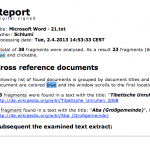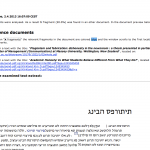Software Profile | Description | Pros & Cons | Report | Usability | Summary | Screenshots | Links
Software Profile
| Nummer | S13-02 |
| Produkt | Open Access Plagiarism Search |
| Hersteller | Technische Universität Braunschweig Institut für Betriebssysteme und Rechnerverbund Mühlenpfordtstraße 23 38106 Braunschweig |
| Web-Site | http://www.ibr.cs.tu-bs.de/projects/oaps/ http://oaps.eu/ |
| Software-Typ | Online |
| Kosteninfo | Beta version is free |
| Testdatum | 02 April 2013 |
Description
OAPS is the abbreviation for Open Access Plagiarism Search and was developed at the Technical University of Braunschweig in Germany. It is still currently only available in a beta version, but is offered for use without additional cost. The goal of OAPS is to use plagiarism searching to increase the trust that people place in Open Access publications. OAPS uses the Docoloc search engine, but looks through open access documents, currently numbering over 12 million. Since the Docoloc engine is being used, the comments that are made for Docoloc also apply here.
Pros & Cons
It is possible to upload more than one file at a time, however, ZIP files are not accepted.
The most problematic aspect seems to be that when calculating the percentages, the entire sentence is considered to be plagiarized even if only a few words are the same as a source. This leads to the system reporting higher percentages that were actually found. In addition, for each text that is reported plagiarized, the user must search for the plagiarized portion in the target document themselves.
The system refused to accept the PDF for which OCR-recognition had been done, and it was also not able to find sources in Google Books or to deal with the Hebrew test cases.
Report
OAPS needed about 25 minutes to prepare the report for the smaller documents. The report is, as is Docoloc, extremely confusing, unstructured, and overly complicated to use. There is no side-by-side view. Since the titles of the documents are not reported, it is difficult to differentiate between the documents. The English is at times completely unintelligible („Subsequent the examined text extract“ means what, exactly?). This makes the use of the system very difficult.
Overall, OAPS does not find many sources, presumably because only the Open Access documents are searched. There were also an unsettling amount of false positives, as common phrases were often marked as plagiarism, for example „zu Wasser, zu Lande und aus der Luft“ was marked as plagiarism in case #53.
Usability
As with Docoloc, it is cumbersome to work with the system. Additionally, not all of the sources named are still available, something that is exceedingly problematic for Open Access documents. The symbols used by the system are not intuitive, and the problematic English translation makes it even more difficult to use.
Summary
Since the system only uses Open Access documents, it only found very little in the way of plagiarism. Since the usability is so problematic, it is in general not useful for use in educational institutions.
Screenshots
- Overview of uploaded documents in OAPS
- Poor English in Docoloc
- Incomprehensible percentages in OAPS



